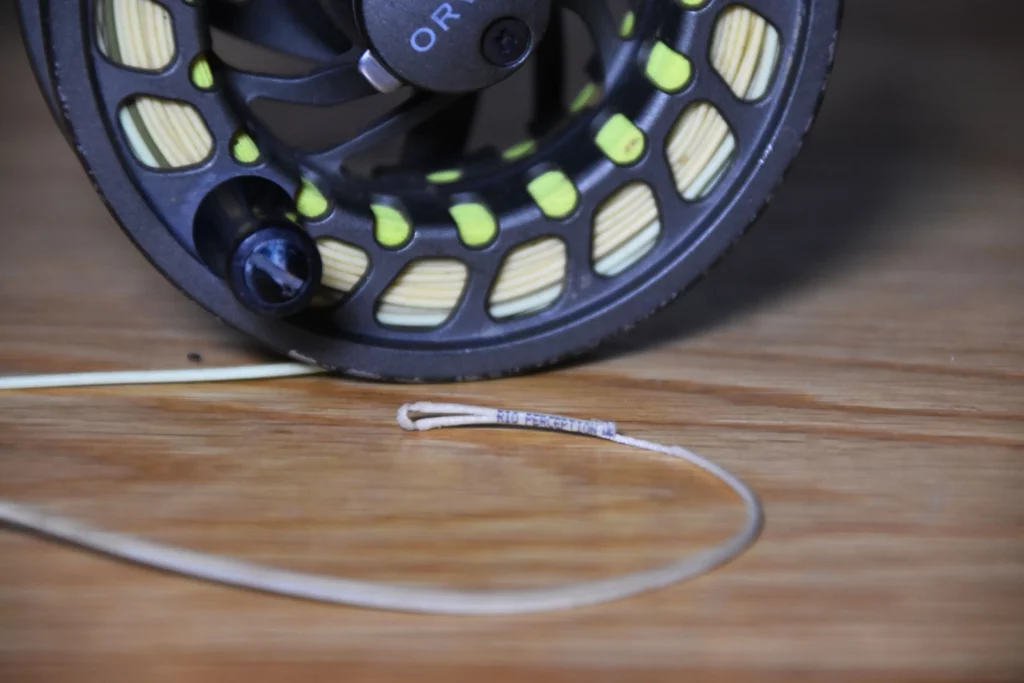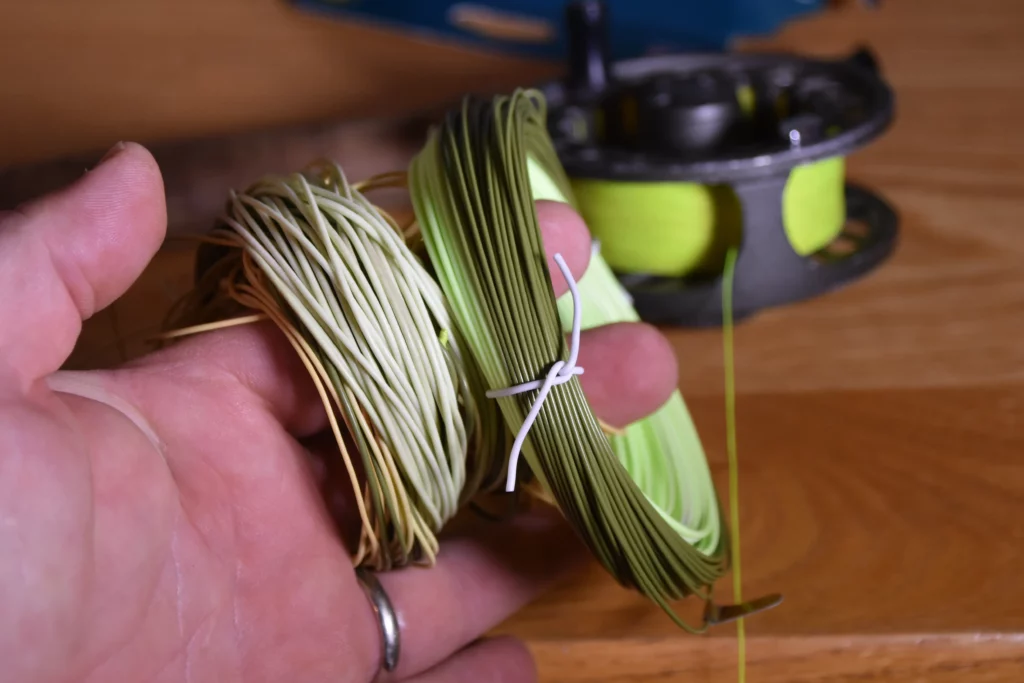When Should Fly Line be Changed?

Fly lines are not cheap, but with regular maintenance, they can last for years. This means cleaning and conditioning the line, properly storing it during long periods between outings, and other general maintenance, all of which require time and effort. And if you’re like me, you might have the best intentions, but work, family, and other obligations often get in the way, and time marches on. Our fly lines get forgotten.
Weeks or months later, though, getting ready for the next fishing excursion, we’re often surprised to find our line is no longer up to snuff. But how do we know if we can squeeze one more season out of it or if it needs replaced? Here are a few things I look for when determining if it’s time to shop for a new fly line.
1. When it’s cracked.
Most fly line has an outer PVC coating over an inner core. With age, and after repeated use, that coating can dry out and become brittle. If it then sits on the reel, coiled up, for a prolonged period of disuse, it’s common to find a series of hairline cracks in the coating. There is simply no way to repair these cracks. In extreme cases, the line can even dry rot, especially if it’s been sitting in a damp basement for prolonged periods of time, and these cracks can be quite severe.
These cracks in the fly line cause two things. First, they create friction which prevents the line from smoothly casting. Accuracy, especially, will suffer. Second, water seeps in through the cracks and causes the front of the line to sink (if it’s a floating line), which can make it a struggle to pick up the line for the next cast, set the hook properly, or even achieve a drag-free drift.

Hare-line cracks allow water to penetrate to the core of the fly line, which can make a floating line start to sink. A good sign you need a new line.
2. When I’ve cut too far into the belly/taper of the line.
At the front end of a fly line is usually a level section simply known as the tip. Many manufacturers include a welded loop at the end of the tip for attaching your leader of choice. Depending on how often you change leaders, or even just use the line, this welded loop is usually the first part to show signs of wear.
Years ago, before welded loop technology was perfected, experts suggested cutting off this loop and attaching the leader directly to the fly line using a nail knot. However, if you’re like me and frequently change setups to fish specific situations (Euronymphing, indicator nymphing, dry fly fishing, etc.), it won’t take long before you have depleted the grace period of the tip and start cutting into the actual taper of the fly line. For this reason, I recommend never cutting off the welded loop.
Back when welded loops were a new idea, they weren’t always reliable, which is why many suggested trimming them. However, technology has much improved and most welded loops will remain intact for the life of the fly line. And if you find that the loop is starting to deteriorate but you can still get a season from your fly line, go ahead and trim it and use the nail knot for attaching the leader.
3. When I notice decreased casting performance.
If the fly line seems like a struggle to cast (beyond my normal deficiencies, that is!), that can be an indication that a change is necessary. Even if a fly line is properly cared for, the general rule of thumb is that it will need replaced after approximately 250 uses. This is an arbitrary number, of course, and highly dependent on the initial quality of the line, the conditions in which it was used, and how it was maintained and stored afterwards.
And sometimes you can do everything right, but the line just gets worn out from extensive use. That’s not a bad thing because it likely means that you’ve done a lot of fishing!

4. When I buy a new rod and reel.
It seems almost blasphemous to put used fly line on a brand new reel, but if you’re on a budget, I guess that’s okay. I mean, there’s no law against it.
All joking aside, there’s nothing wrong with putting old line on a new rig, but only if it’s matched for that particular setup. A mismatched line and rod won’t perform as expected or intended by the manufacturer. (You can read more about why this is important in this post about fly line weights and what they mean.) In other words, a quality rod is only as good as the quality of the line you pair it with, so don’t try to “get by” with a line that’s too heavy or too light, or not well-suited for the type of fishing you plan to do, just to save a few bucks.
Quality fly lines are worth the investment, but even the best ones, and even when properly maintained, won’t last forever. Hopefully a few of the topics covered here will help you know when it’s time to shop for a new fly line
Did You Find This Guide To Be Helpful?
Stay up to date with the Dark Skies Fly Fishing monthly newsletter for free and receive the latest posts in fly fishing news, tricks, tips, and techniques, stream reports, as well as updates on new flies added to the Online Store and exclusive discounts!
Sign Up Now
This is a quick and informative read, Ralph, that includes several tips that I need to consider conscientiously.
I tend to fish the same fly lines for season after season after season after season… Well, you get the picture. For my Euro nymphing lines, this is seemingly less of a concern. Afterall, rarely do my Euro lines ever leave the fly reel? If they do, it is when a bruiser fish in big, heavy water takes me there. And, that is not often at all. I can count the number of times on one hand that has happened after placing hundreds of trout in the net per year.
Nevertheless, I do notice the problem of fishing old lines with those that I actually cast and lay on the water. These are principally my dry fly and/or streamer floating lines. And, gasp, those that I indicator nymph with, but please do not mention that to anyone. The first problem encountered is that these fly lines pick up particles and micro-debris from the water. This is especially true when fishing conditions constitute highly stained, dirty water.
I like to use any numbers of fly line conditioners and cleansers. I have used products from Loon Outdoors, Orvis and 3M. It is amazing the amount of crud and gunk left behind on a towel after running the line through a few drops of product. These products not only clean the line but condition it, too with a wax-like lubricant. And, I believe with conviction that this prolongs the life of my fly lines and helps them float higher.
Second, when storing my reels, I keep them in reel sleeves in a duffel or on a shelf in a dark and dry basement room. I believer that harmful UV light can really damage the PVC surfaces of lines due to prolonged exposure. So, it is best to store lined reels in a dry and dark environment. Just do not put the lined reels away wet for a length of time, for this can create additional damage to reel parts and fly line surfaces, too. After a session on the water, I rinse my lined reel spools and reel frames in cool, fresh tap water under very light pressure. I then allow these two parts to fully dry separated on a shelf. Reel maintenance and care is another discussion in its own right.
Be safe, have fun and go fishing.
Justin